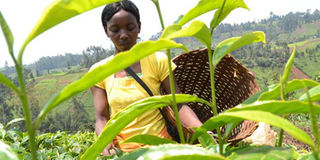What you did not know about pricing of tea

A farmer picks tea leaves in Chinga in Othaya, Nyeri. PHOTO | JOSEPH KANYI | NATION MEDIA GROUP
What you need to know:
There are three critical areas where the smallholder tea industry suffers the greatest amount of disinformation.
These are what constitutes a kilo of tea in the market, the pricing of tea and the role of the Kenya Tea Development Agency in the value chain.
A few weeks ago, I spent time with a group of small- holder tea farmers in the Kisii region. Despite the myriad challenges they face, it was evident that these farmers represent all that is right within this country – industrious, hopeful, united in diversity, willing to learn and adopt new methods and entrepreneurial.
What I found troubling is that the same farmers have to shift through loads of alternative information, most of it in the form of rumours, innuendos and half-truths. The sources are varied – from aspiring factory company directors to illegal tea buyers, aspiring Members of County Assembly and all manner of people in between.
There are three critical areas where the smallholder tea industry suffers the greatest amount of disinformation. These are what constitutes a kilo of tea in the market, the pricing of tea and the role of the Kenya Tea Development Agency (KTDA) in the value chain. Let me attempt to break this down to correct some misinformation that has caused confusion among some smallholder tea farmers.
One kilo of green leaf delivered by a farmer to the tea collection centre is not the same as one kilo of made tea sold at the tea auction in Mombasa. During tea processing, four kilos of green leaf is required to make one kilo of made tea. For a farmer to know the value of their kilo of green leaf, he or she should divide their green leaf deliveries for the reporting period by four. If a kilo of made tea, for instance, sold for Sh200 at the auction, then the value of a kilo of green leaf will be Sh200 divided by four, which is Sh50. What is due to the farmer for a kilo of green leaf will be Sh50 less cost of production and the cost of delivering the tea to Mombasa from the respective factories.
MOST SENSITIVE
The second aspect – pricing – is perhaps the most sensitive of all. Prominent politicians and other interest groups have in the past caused furore in some tea growing areas by alleging discrimination where variations exist between the earnings of factories in one region compared to another. Critics have been quick to read politics and favouritism in such instances, causing despondency and confusion among farmers.
The price of tea is neither determined by the KTDA nor any government agency. As in most businesses, pricing is solely a function of the market. The factors that determine price at the auction include the demand and supply function, currency exchange rate, political stability in key export markets and the unique attributes of individual teas.
When the market is flooded with tea, for instance, when tea growing areas experience above normal rainfall or when other tea producing countries bring more tea to the market than they usually do, the demand is bound to suffer and, with it, the price.
Currency exchange rate is significant here because tea sales are usually denominated in foreign currency, primarily the American dollar. When the value of the shilling depreciates against the dollar or the value of the dollar appreciates against the shilling, farmers on average earn more from each kilo sold.
SHILLING APPRECIATES
The reverse happens when the shilling appreciates against the dollar or the dollar depreciates against the shilling. But whereas a weak shilling is good for exporters, it is bad news for importers. In our context, tea farmers do not just export made tea, they also import inputs such as fertiliser and factory machinery. A stable currency is, therefore, the best bet for the industry. Political stability as a factor of pricing is relatively straightforward and, thankfully, it is not an everyday occurrence. Kenyans will recall how the industry suffered immensely when political instability befell Egypt, one of the top three importers of Kenya’s tea.
The point I must dwell on in a little more detail is what has been described as unique attributes of individual teas. The unique attributes in tea are conferred by the soil type and differential climatic conditions.
It is not a physical attribute that can be seen with the naked eye but buyers are often prepared to pay more for teas with a particular attribute. Teas from Meru, Embu, Nyeri, Kirinyaga, Murang’a, Kiambu, Kisii, Kericho, Vihiga, Nandi and Bomet are all different in terms of their individual attributes. It is not surprising to see a buyer from the United Kingdom, for instance, willing to pay more for Nyansiongo tea while offering standard price for tea from a different area.
The final area of disinformation is the role of the KTDA in the tea value chain. The majority of the 560,000 smallholder tea farmers own holdings so small that they wouldn’t survive without the economies of scale afforded by the KTDA.
Fred Gori is a communication specialist.




